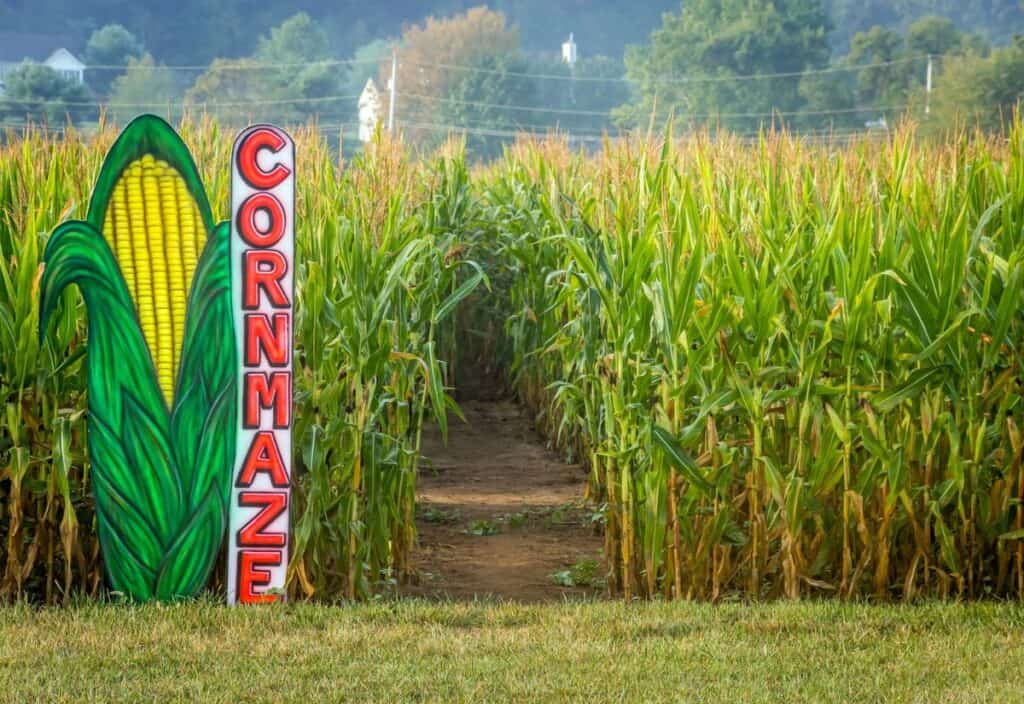Corn mazes across the United States attract crowds every October, turning farm fields into some of fall’s biggest attractions. Many now feature themed paths that double as trivia games or scavenger hunts, adding layers of challenge beyond simply finding the exit. Each design comes to life through detailed layouts and technology that make every maze unique and worth visiting.

Many farms update their themes annually, introducing new storylines or patterns that add surprise for returning guests. Others add family-friendly activities that cater to both children and adults, from kid-focused games to seasonal markets that extend the visit on top of the maze experience.
The origins of the corn maze
Mazes have fascinated people for centuries, appearing in war defenses, garden paths and as diversions for European nobility in the 17th century. Those hedge mazes laid the foundation for today’s cornfield versions, where visitors wind through tall stalks in search of an exit.
The modern corn maze debuted in Pennsylvania in 1993, when creative director Don Frantz envisioned the idea while flying over farmland. He partnered with British designer Adrian Fisher to carve a dinosaur called Cornelius the Cobasaurus into a three-acre field, with workers pulling stalks by hand to complete the design.
Dubbed “The Amazing Maize Maze,” the attraction drew national attention and inspired farmers across the country to adapt their own fields into playful labyrinths. The novelty of getting lost in an agricultural landscape quickly caught on, turning a centuries-old idea into one of America’s signature fall pastimes.
Farms grow fall businesses
Corn mazes quickly proved valuable to farmers as a way to bring in extra income beyond crop sales. They often grow into larger attractions, paired with pumpkin patches, hayrides, cider stands and farm markets that encourage visitors to stay longer.
Themed designs become marketing tools on their own, drawing media attention and pulling in visitors from surrounding regions. Communities embrace them as gathering spots, hosting fundraisers, field trips and local celebrations inside the maze walls. Annual redesigns keep people coming back, while the tie to autumn traditions positions corn mazes as reliable tourism drivers for small towns during the season.
Bigger fields and bolder designs
Today’s farms create corn mazes that can cover 10 to 60 acres and promote them as the biggest in their area. Fields form detailed patterns that range from portraits and logos to themes based on history or pop culture. Farmers use GPS and drone technology to map paths with precision, making designs more complex than ever.
The scale is most striking from above, where aerial photos capture the full picture and often circulate on social media or in the press. On the ground, visitors find more than just twists and turns, with scavenger hunts and checkpoints adding to the challenge. Many farms keep the crowds coming after dark with flashlight tours or haunted versions that add a different kind of thrill. Observation decks and drone footage provide photo-ready views, turning each maze into a game and a visual attraction.
Explore America’s largest mazes
Across the country, farms transform their fields into large-scale mazes that double as community hubs. In Texas, At’l Do Farms mixes traditional attractions like a pumpkin patch, sunflower field and cow train with concessions at the Windmill Grill. The farm even adapts to drought by using sorghum, sunflowers, millet, cowpeas and other crops to shape its maze paths.
California’s Cool Patch Pumpkins holds a Guinness World Record for one of the largest mazes on the planet. Beyond the maze, the site offers a hay castle, corn bath and hayrides, and it partners with schools and churches for field trips.
In Virginia, Liberty Mills Farm spreads its 34-acre maze across four themed trails that range from trivia challenges to mystery paths, offering up to 12 miles of exploring. Further north, the Great Vermont Corn Maze covers more than 24 acres with tall corn walls, dirt trails, bridges and even an underground tunnel, along with extras such as barnyard golf and a hide-and-seek maze.
Challenges and best practices
Running a corn maze is not without hurdles. Weather plays a major role, as drought, heavy rain or early frost can damage crops and shorten the season. Pests and plant disease add more risk, and keeping stalks tall and healthy takes steady care throughout the growing months. Large mazes also require significant labor, from cutting and shaping paths to maintaining trails for visitors.
Costs extend beyond the field. Marketing, staffing, insurance and add-on attractions all add to the investment. Managing visitor flow is another concern, since peak weekends can bring crowds that create bottlenecks. To stay ahead, farms use GPS and drones for precision cutting, add checkpoints to improve safety, provide maps or mobile apps and refresh designs each year to bring guests back.
Celebrate fall in the fields
Corn mazes have grown from a single experiment into one of America’s most recognizable fall attractions. What started as a creative way to use farmland has become a cornerstone of agritourism, bringing in families, tourists and school groups every year. Farmers rely on careful planning and upkeep to keep the experience running, using new tools and designs to stay exciting. With farming skill and imagination, corn mazes continue to thrive as reliable fall traditions that celebrate community spirit and agricultural creativity.
Zuzana Paar, a co-founder of Food Drink Life, is a seasoned traveler and writer who has explored 62 countries and lived in St. Lucia, Dubai, Vienna, Doha and Slovakia. Her work has been featured on Fox News, New York Daily News, MSN and more; she has also appeared live on Chicago’s WGN Bob Sirott Radio Show. When she’s not discovering new destinations, she shares travel tips and insider insights to help others experience the world in a unique and unforgettable way.
The post Corn mazes grow into full-scale fall attractions across America appeared first on Food Drink Life.













(0) comments
Welcome to the discussion.
Log In
Keep it Clean. Please avoid obscene, vulgar, lewd, racist or sexually-oriented language.
PLEASE TURN OFF YOUR CAPS LOCK.
Don't Threaten. Threats of harming another person will not be tolerated.
Be Truthful. Don't knowingly lie about anyone or anything.
Be Nice. No racism, sexism or any sort of -ism that is degrading to another person.
Be Proactive. Use the 'Report' link on each comment to let us know of abusive posts.
Share with Us. We'd love to hear eyewitness accounts, the history behind an article.